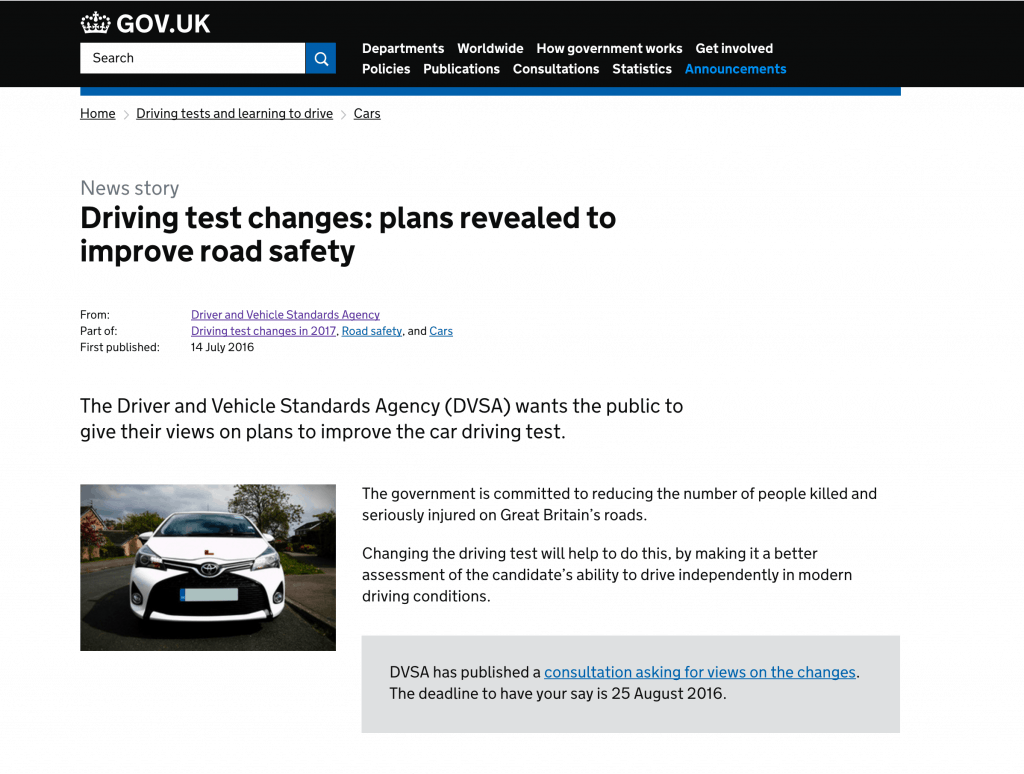Driving Test Changes from the DVSA
Part of the government’s commitment to reducing serious and fatal injuries on Britain’s roads, these driving test changes are designed to help achieve this by enabling better assessment of candidates’ ability to drive unaccompanied in today’s driving conditions. In addition to extending the current 10-minute ‘independent driving’ element of driving tests to 20 minutes, the proposed driving test changes include:
- Candidates being asked to follow sat nav directions during their ‘independent driving’ test.
- Current ‘turn in the road’ and ‘reverse around a corner’ manoeuvres being replaced by more realistic scenarios such as, for instance, driving into parking bays and reversing back out of them.
- Candidates being asked one of their 2 ‘show me, tell me’ vehicle safety questions while driving.
Examiners may, for example, ask candidates to use the vehicle’s heated rear screen.
The Importance of these Driving Test Changes – Sat Nav Driving Lessons
Accounting for more than 25 per cent of all death among people aged 15 to 19, collisions on the road are the largest single reason for young people’s deaths. Aiming to ensure that their training and driving tests help reduce the numbers of fatal injuries to young people, the DVSA proposed these driving test changes because:
- Most fatal collisions occur on high-speed stretches of road (this does not include motorways). By changing the test’s format, more of these road types can be included in test routes.
- More than half (52 percent) of drivers now use sat navs. The DVSA wants learner drivers to be trained in safely using them.
- Research revealed that ‘independent driving’ training regarded as valuable by new drivers, as they can tie it in with driving after passing their tests.
Research into How Drivers Will Be Affected By the Driving Test Changes
The driving test changes were trialled by the DVSA and the TRL (Transport Research Laboratory) across 32 test centres during 2015/16. These trials revealed that the driving test changes are believed to:
- Provide a good basis in terms of independent decision making and driving and relevant to ‘driving in the real world’ by supervising drivers, test passers and ADIs
- Provide greater insight into their own driving skills and improve their confidence that they will be safe, good drivers able to use sat navs safely by the individuals who passed their tests during the trails.
You can learn more about these driving test changes and see the full trial report here: New Driving Test Trial.
Safe Driving for Life
Talking about the changes, Gareth Llewellyn, the DVSA’s Chief Executive, said: “British roads are among the world’s safest roads. We, however, still do more to keep road users – and especially newly-qualified drivers – safe. Ensuring driving tests assess new drivers’ ability to drive independently and safely forms part of our strategy, which is to help all drivers through a lifetime of safer driving.”
Lesley Young, the DVSA’s Chief Driving Examiner, added to this by stating: “We want candidates to show their ability to assess risks and cope with distractions without instructor/examiner interventions, so they will be given increased decision-making responsibility during their test.”
Road Safety Professionals’ Support
Initial feedback on the proposed driving test changes provided by both trial participants and driver training industry representatives – including driving instructor associations, the AA and the RAC, as well as the RoSPA (Royal Society for the Prevention of Accidents) and the IAM (Institute of Advanced Motorists) – was both positive and supportive.
Carly Brookfield (CEO, Driving Instructors Association) said that the association ‘fully welcomes these test developments’, adding: “The evidence presented by the trial compels us to recommend that these well-overdue changes are made to driving tests – which have remained fundamentally unchanged for more than 20 years and have failed to keep pace with how British roads and driver behaviour have developed over time.”
Mark Peacock, Head of BSM, responded to the trials’ findings by stating: “The proposed practical driving test changes, especially the use of a sat nav and extended independent driving duration, should help us in producing safer, better motorists. Having received positive feedback from both our instructors and their students, we fully support the introduction of these changes.”
Edmund King OBE, the President of the AA, also responded positively by saying: “We know that new drivers pose an increased risk on the road. We, therefore, need to prepare them better for driving in the real world. These driving test changes will test learner drivers in a more realistic fashion, which is imperative in improving their safety upon removal of their L plates.”
Please note: All quotes have been paraphrased to avoid copyright infringements.
Intensive Courses Driving School
We also fully support these driving test changes and will, of course, be offering the necessary sat nav driving and special driving manoeuvres lessons as part of our intensive driving lessons. For more detailed information, please do not hesitate to explore our Website (and in particular our ‘What You Need to Know’ page), contact us online or give us a call on 0333 366 1251 or 0207 205 2251. You can also book your driving lessons online.
Did you fail your Driving Test?
To make sure you will pass your Driving Test next time, make sure to read this article: Pass your Driving Test First Time!
Last updated: 09/11/2022



